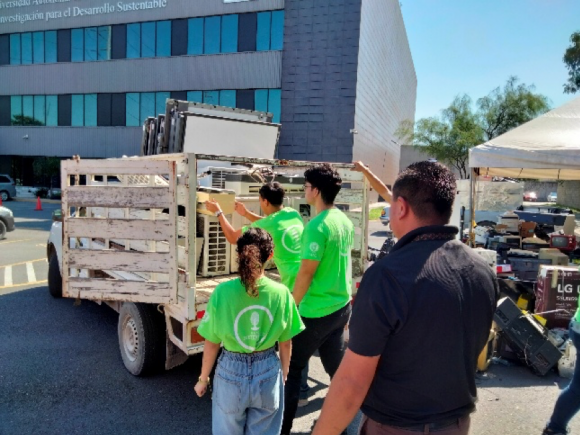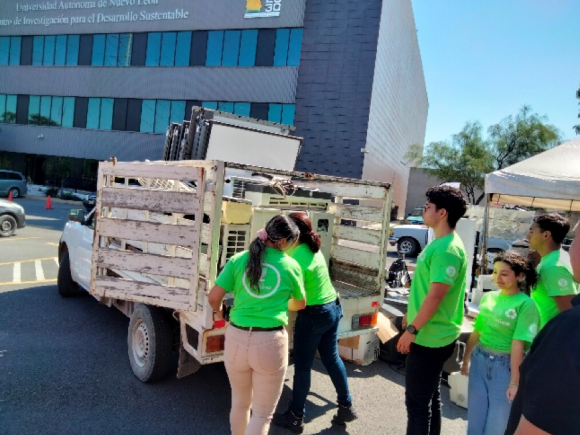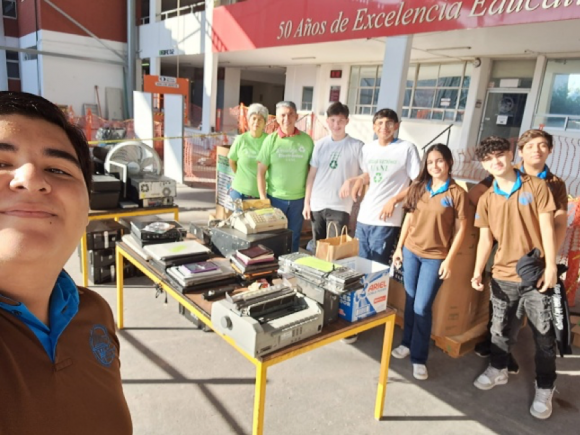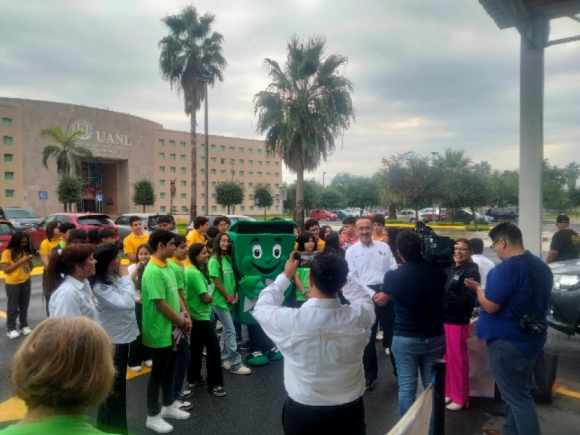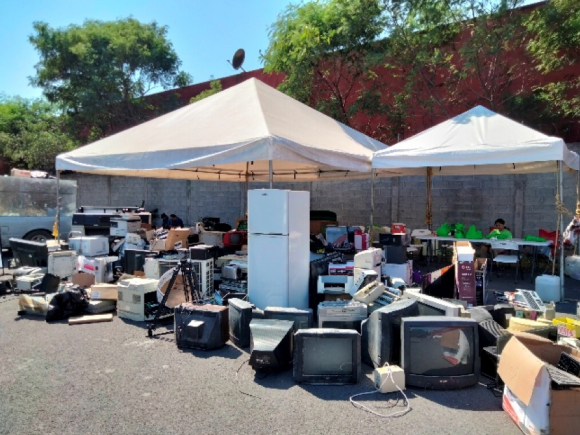
UNIVERSIDAD AUTÓNOMA DE NUEVO LEÓN
SECRETARÍA DE SUSTENTABILIDAD
Special management waste (SMR)
EMR are those generated in production or service processes, which do not meet the characteristics to be considered as hazardous or as urban solid waste, or which are produced by large generators of urban solid waste according to the General Law for the Prevention and Comprehensive Management of Waste (LGPGIR). According to the Basic diagnosis for integrated waste management (SEMARNAT 2012) 84 million tonnes (Mt) of EMR from 14 EMR streams are generated annually and the numbers are on the rise.
Waste electrical and electronic equipment (WEEE)
The world is experiencing a significant era of digital transformation, with technologies significantly influencing the way we live, work, learn, socialize, and do business. More and more people own and use multiple electronic devices, and the increasing interconnectivity of urban and remote areas has led to an increase in the number of devices linked to the Internet. This has led to a considerable increase in the amount of waste electrical and electronic equipment (WEEE). However, the generation of WEEE and the rate of collection and recycling is not keeping pace with this growth. According to the “Global E-waste Monitor”, in 2022, 62 billion kg of WEEE were generated worldwide, an average of 7.8 kg per capita, of which only 22.3% was documented as correctly collected and recycled. WEEE generated in 2022 contained 31 billion kg of metals, 17 billion kg of plastics and 14 billion kg of other materials (minerals, glass, etc.).
One of the main characteristics of WEEE is that it contains substances (lead, cadmium, mercury, chromium and persistent organic compounds) that, due to their properties, can cause toxic effects on health and the environment if not handled properly. It also contains substances with a high economic value (palladium, gold, silver, copper, ruthenium, indium, etc.) that can be recycled and reincorporated as raw material for new products. A group of hazardous substances contained in WEEE are halogenated flame retardants, such as polybrominated biphenyls (PBB), polychlorinated biphenyls (PCB) and polybrominated diphenyl ethers (PBDE). These compounds were incorporated into the Stockholm Convention (EC) in 2009, to which Mexico and 180 other countries are party. In addition to PBDEs, the best practice approach covers other significant contaminants potentially present in WEEE, consisting primarily of various heavy metals, such as lead, mercury, cadmium, among others; as well as the so-called rare earths and other elements such as beryllium, antimony, among others. There are other categories of contaminants such as ozone-depleting substances, or gases classified as greenhouse gases. Generally, these contaminants are found in a particular and practically limited way to one category of WEEE, represented by heat exchange equipment such as refrigerators and air conditioning equipment, among others containing chlorofluorocarbons (CFCs) and hydrochlorofluorocarbons (HCFCs). The environmentally sound management of WEEE must obviously contemplate the consideration with a comprehensive approach of all the contaminants present in them, as well as their maximum level of use; said contaminants are presented in the following table:
By 2023, eighty-one countries (42% of all countries in the world) have adopted policies or legislation on WEEE. In Mexico, the Ministry of Environment and Natural Resources (SEMARNAT) has developed Official Standards to control the management of such waste, for example, NOM-161-SEMARNAT-2011, which establishes the criteria for classifying Special Management Waste and determining which are subject to a Management Plan; the list of the same, the procedure for inclusion or exclusion from said list; as well as the elements and procedures for the formulation of management plans. Likewise, there is the General Law for the Prevention and Comprehensive Management of Waste, which requires generators of special management waste to have management plans. The legislation in Mexico is based on the principle of shared responsibility, that is, all interested parties are involved: producers, exporters, marketers, consumers, waste management companies.
Electronic recycling campaigns at UANL
WEEE is often disposed of inappropriately, which can promote the production of leachates that release toxic chemicals that can filter through the soil and contaminate aquifers and therefore harm our body by drinking water contaminated with heavy metals, which in high quantities can cause serious health effects such as:
- Acute poisoning
- Neurological damage
- Respiratory tract damage
- Cardiovascular conditions
- Liver and kidney damage
- Osteoporosis and bone deformities
- Cancer
- Damage to the immune system
En el año 2024, en la UANL se recolectaron 11.46 toneladas de RAEE durante la campaña de reciclaje electrónico realizada por la SS en el mes de octubre y en la Jornada de reciclaje del mes de junio.
En esta gráfica se muestra los porcentajes de los diferentes tipos de RE recolectados en dicha campaña.

By recycling the above-mentioned quantities, important environmental benefits were obtained, such as:

Once the waste has been collected by a service provider authorized by the State Environment Secretariat, it is taken to collection centers where it is classified into groups and separated into its different components. For example, plastic is taken to local recycling plants to be incorporated as raw material for the production of new products such as toys and pallets; copper and aluminum are sent to a national foundry for the production of electric cables, copper pipes, aluminum coils, etc. Finally, electronic cards and power supplies are sent to foreign companies where precious metals, among other materials, are recovered to be incorporated into other production cycles for the production of cell phones, car windows, fans, pens, etc. Given the above, the waste generated at the UANL follows a circular economy model like shown in the next figure:
The economic amount collected from the commercialization of the materials collected in the electronic recycling campaigns is used to grant the Award for best sustainability project donde pueden participar alumnos inscritos, profesores y personal administrativo que se encuentren laborando en la UANL .La convocatoria se realiza de forma anual .El proyecto debe destacar la importancia en alguno de los ámbitos de la sustentabilidad: social, económico o ambiental y su impacto en la comunidad universitaria. En la edición 2024 el ganador fue la Facultad de Ciencias Químicas con el proyecto titulado “Green in Mind”. Dicho premio fue entregado por el Dr. Sergio Fernández Delgadillo, Secretario de Sustentabilidad de la UANL, al equipo ganador durante la 16ª Reunión de Enlaces para la Sustentabilidad.
Waste fats and oils from cafeterias
Waste generated from vegetable and/or animal oils and fats used in food preparation is one of the main causes of contamination of surface and groundwater due to uncontrolled dumping. It is estimated that one litre of used oil can contaminate 1,000 to 10,000 litres of water, causing blockages, bad odours and the proliferation of pests in drainage and/or sewage systems. It can even harm the soil, seriously affecting its fertility by altering its biological and chemical activity.

Given the above, the UANL promotes a program to collect vegetable oil generated in the cafeterias that operate within the Campuses, so that it is later collected by a company specialized in the field such as SONNE energéticos S.A. de C.V.
En el 2024 se recolectaron 21.54 t de aceite vegetal para ser reciclado y posteriormente ser utilizado en la fabricación de productos químicos amigables con el medio ambiente además de biocombustibles. Actualmente se tiene un avance del 58% en la instalación de trampa de grasas y aceites en las cafeterías de la UANL para dar cumplimiento a lo estipulado en las Normas Oficiales Mexicanas NOM-002-ECOL-1996 “Límites máximos permisibles de contaminantes en las descargas de agua residuales a los sistemas de alcantarillado urbano o municipal” y NOM-251-SSA1-2009 “Prácticas de higiene para el proceso de alimentos, bebidas o suplementos alimenticios”.
La trampa de grasas y aceites retiene por sedimentación los sólidos en suspensión y por flotación el material graso, cuenta con dos compartimentos, ambos separados por una rejilla de acero inoxidable encargada de no dejar pasar sólidos. En el compartimento más grande, por donde llegan los líquidos con sólidos disueltos, la grasa se separa al ser más liviana que el agua. Por el otro compartimento va a salir el agua “limpia”. Contar con trampa de grasas y aceites permite evitar consecuencias como:
- Pipe blockage
- Maintenance cost overruns
- Harm to public health
- Fire risk
- Pollution of the environment, especially water





